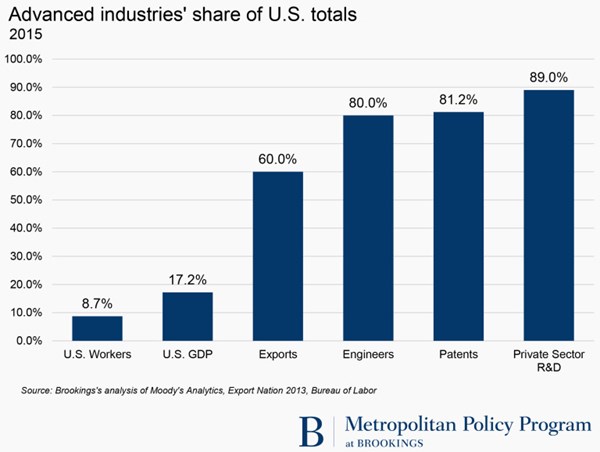Advanced Manufacturing Has Outsized Impact U.S. Economy
But overall impact is waning, pointing to need for federal and state-local strategies to boost the sector’s growth and broaden its reach.
But overall impact is waning, pointing to need for federal and state-local strategies to boost the sector’s growth and broaden its reach.
Earlier this month, think tank The Brookings Institution released a report with those findings and more entitled “America’s Advanced Industries: New Trends” by Brookings Fellow Mark Muro, former Research Analyst Siddharth Kulkarni, and Nonresident Senior Fellow David Hart.
The report found that the overall sector expanded between 2013 and 2015, despite global headwinds, including China’s slowdown. That growth, however, was concentrated in a sliver of auto manufacturing and “tech” service industries, with three auto industries and four digital services industries taking up more than 60 percent of the nation’s advanced-sector growth during that time.
Forward 50
This report is a follow up on February 2015 paper by Brookings entitled “America’s Advanced Industries: What They Are, Where They Are, and Why They Matter”. In that, Brookings identified 50 industries that constitute the advanced industries sector. Those 50 were further broken down into three primary groups—manufacturing, energy, services—of which manufacturing was the largest with 35 categories.
Of those, many were directly related to plastics, like “resins and synthetic rubbers, fibers, and filaments” with more that touched on segments which rely heavily on polymers like aerospace and motor vehicle parts, medical equipment and household appliances. Resin and rubber was one of only 10 advanced industries that ran a trade surplus, trailing only royalties and aerospace.
Why Do These Advanced Industries Matter?
These manufacturing-heavy sectors are so important to the U.S. economy because of their outsized influence on it. According to Brookings, the advanced sector conducts 89 percent of the nation’s private-sector R&D and generates more than 80 percent of the nation’s patents.
In terms of overall productivity, the advanced industries sector has grown about 2.7 percent annually since 1980, far faster than has the rest of the economy, which has managed annual productivity growth of just 1.4 percent.
Finally, there is the impact on trade. The advanced industries sector generates 60 percent of U.S. exports despite representing less than 10 percent of the nation’s employment.
Concentrated Growth
Despite slower growth from 2010–2013, advanced manufacturing industries still added more than 132,000 jobs from 2013–2015 period, taking up 20 percent of all advanced-sector employment growth. Roughly 70 percent of that employment growth came in three auto-related industries: motor vehicle parts, motor vehicles, and motor vehicle body and trailers
High-tech service industries were the leading source of advanced-sector growth in the 2013–2015 period, adding 500,000 new jobs over that time or 80 percent of new advanced-sector jobs. Nearly two-thirds of those came in four spaces: computer systems design, web search and internet publishing, software and products, and data processing and hosting.
Energy Bust
The advanced-energy sector has gone from a significant contributor in the 2010–2013 period to a “bust,” according to report author, Muro. “The U.S. ‘fracking” boom led to an oil and gas glut and energy demand stagnated worldwide.”
Going forward, the report sees two immediate issues to be addressed.
“This report speaks to two of the nation’s most pressing economic problems: its serious inclusion crisis and its stubborn productivity slump. On both counts, the vitality and expansion of the advanced-industries sector is crucial because the sector is the main source of the productivity growth and productivity-driving innovations and business models that support higher wages and rising living standards for the average worker.”

Related Content
BMW Group Vehicle to Adopt 3D Printed Center Console
A vehicle coming to market in 2027 will include a center console carrier manufactured through polymer robot-based large-format additive manufacturing (LFAM).
Read MoreThin, High-Performance Nylon/PE Barrier Film for Thermoformed Packaging
Südpack’s Multifol Extreme film is well suited for greasy, protein-rich and frozen foods
Read MoreWhat to Look for in High-Speed Automation for Pipette Production
Automation is a must-have for molders of pipettes. Make sure your supplier provides assurances of throughput and output, manpower utilization, floor space consumption and payback period.
Read MorePaperless ‘Smart Factory’ Based on Automated Production Monitoring
Tier 1 automotive molder’s home-built production-monitoring and ERP systems, designed for “the little guy,” boost its efficiency rating and profits.
Read MoreRead Next
People 4.0 – How to Get Buy-In from Your Staff for Industry 4.0 Systems
Implementing a production monitoring system as the foundation of a ‘smart factory’ is about integrating people with new technology as much as it is about integrating machines and computers. Here are tips from a company that has gone through the process.
Read MoreLead the Conversation, Change the Conversation
Coverage of single-use plastics can be both misleading and demoralizing. Here are 10 tips for changing the perception of the plastics industry at your company and in your community.
Read MoreBeyond Prototypes: 8 Ways the Plastics Industry Is Using 3D Printing
Plastics processors are finding applications for 3D printing around the plant and across the supply chain. Here are 8 examples to look for at NPE2024.
Read More

























